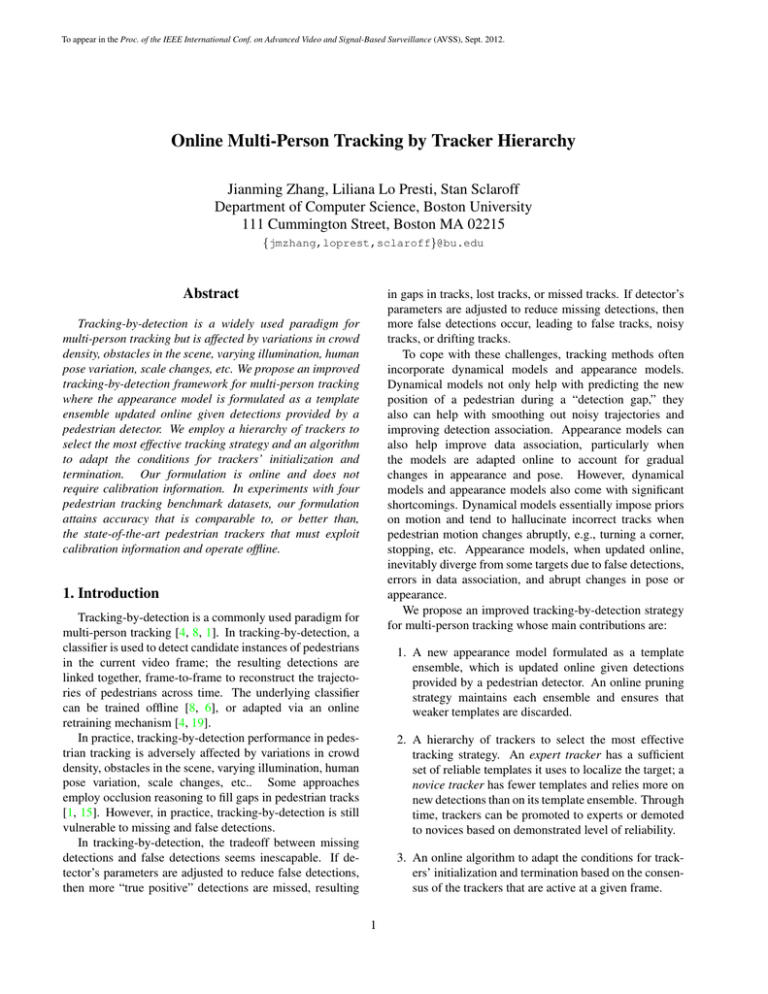Online Multi-Person Tracking by Tracker Hierarchy
advertisement

To appear in the Proc. of the IEEE International Conf. on Advanced Video and Signal-Based Surveillance (AVSS), Sept. 2012.
Online Multi-Person Tracking by Tracker Hierarchy
Jianming Zhang, Liliana Lo Presti, Stan Sclaroff
Department of Computer Science, Boston University
111 Cummington Street, Boston MA 02215
{jmzhang,loprest,sclaroff}@bu.edu
Abstract
in gaps in tracks, lost tracks, or missed tracks. If detector’s
parameters are adjusted to reduce missing detections, then
more false detections occur, leading to false tracks, noisy
tracks, or drifting tracks.
To cope with these challenges, tracking methods often
incorporate dynamical models and appearance models.
Dynamical models not only help with predicting the new
position of a pedestrian during a “detection gap,” they
also can help with smoothing out noisy trajectories and
improving detection association. Appearance models can
also help improve data association, particularly when
the models are adapted online to account for gradual
changes in appearance and pose. However, dynamical
models and appearance models also come with significant
shortcomings. Dynamical models essentially impose priors
on motion and tend to hallucinate incorrect tracks when
pedestrian motion changes abruptly, e.g., turning a corner,
stopping, etc. Appearance models, when updated online,
inevitably diverge from some targets due to false detections,
errors in data association, and abrupt changes in pose or
appearance.
We propose an improved tracking-by-detection strategy
for multi-person tracking whose main contributions are:
Tracking-by-detection is a widely used paradigm for
multi-person tracking but is affected by variations in crowd
density, obstacles in the scene, varying illumination, human
pose variation, scale changes, etc. We propose an improved
tracking-by-detection framework for multi-person tracking
where the appearance model is formulated as a template
ensemble updated online given detections provided by a
pedestrian detector. We employ a hierarchy of trackers to
select the most effective tracking strategy and an algorithm
to adapt the conditions for trackers’ initialization and
termination. Our formulation is online and does not
require calibration information. In experiments with four
pedestrian tracking benchmark datasets, our formulation
attains accuracy that is comparable to, or better than,
the state-of-the-art pedestrian trackers that must exploit
calibration information and operate offline.
1. Introduction
Tracking-by-detection is a commonly used paradigm for
multi-person tracking [4, 8, 1]. In tracking-by-detection, a
classifier is used to detect candidate instances of pedestrians
in the current video frame; the resulting detections are
linked together, frame-to-frame to reconstruct the trajectories of pedestrians across time. The underlying classifier
can be trained offline [8, 6], or adapted via an online
retraining mechanism [4, 19].
In practice, tracking-by-detection performance in pedestrian tracking is adversely affected by variations in crowd
density, obstacles in the scene, varying illumination, human
pose variation, scale changes, etc.. Some approaches
employ occlusion reasoning to fill gaps in pedestrian tracks
[1, 15]. However, in practice, tracking-by-detection is still
vulnerable to missing and false detections.
In tracking-by-detection, the tradeoff between missing
detections and false detections seems inescapable. If detector’s parameters are adjusted to reduce false detections,
then more “true positive” detections are missed, resulting
1. A new appearance model formulated as a template
ensemble, which is updated online given detections
provided by a pedestrian detector. An online pruning
strategy maintains each ensemble and ensures that
weaker templates are discarded.
2. A hierarchy of trackers to select the most effective
tracking strategy. An expert tracker has a sufficient
set of reliable templates it uses to localize the target; a
novice tracker has fewer templates and relies more on
new detections than on its template ensemble. Through
time, trackers can be promoted to experts or demoted
to novices based on demonstrated level of reliability.
3. An online algorithm to adapt the conditions for trackers’ initialization and termination based on the consensus of the trackers that are active at a given frame.
1
To appear in the Proc. of the IEEE International Conf. on Advanced Video and Signal-Based Surveillance (AVSS), Sept. 2012.
In experiments with four pedestrian tracking benchmark
datasets, our formulation attains accuracy that is comparable to, or better than, state-of-the-art pedestrian trackers.
But unlike these other methods, our formulation is online
and does not require calibration information.
2. Related Work
In recent years, several works combined discriminative
and generative methods for tracking, e.g. [3, 8, 16]. In
these works, offline trained detectors and standard tracking
techniques are combined, and the detectors are used in a
tracker’s appearance/observation model.
Some works integrate the detector’s response as well as
motion and appearance models into a global optimization
framework [2, 13, 6]. In others, a data association problem
is formulated to link detections through time [7, 5]. These
techniques are based on offline approaches, and require
calibration information. In contrast to these approaches, we
present a fast online method to track multiple pedestrians
with an uncalibrated camera.
Some tracking-by-detection methods employ the meanshift tracker [10], which searches for the detection whose
appearance best matches the target via a gradient ascent
procedure. In [9], mean-shift tracking is coupled with
online adaptive feature selection. Features are selected
to separate the target from the background; the most
discriminative features are used to compute weight images.
Then the mean-shift tracker is applied on each of the weight
images to localize the target. Based on the new target
detection, foreground/background samples are selected to
compute a new set of discriminative features.
In [4], at each frame weak classifiers are trained to discriminate between pixels on the target vs. the background.
Online AdaBoost is used to train a strong classifier. Meanshift is applied on the classifier’s confidence map to localize
the target. In [19] several classifiers are co-trained to detect
the object and reach a consensus on the predicted location.
In all these methods, the appearance model is fully
dependent on the tracker’s detection. Moreover, in [4, 19],
the classifiers are dependent one each other and, through
time, they may correlate. In our approach, we adopt
the mean-shift tracker, but the appearance model consists
of a pool of templates found by the pedestrian detector.
The template ensemble is updated over time adding or
removing templates; however, as the templates are found
by the pedestrian detector and not by the tracker itself, the
templates are independent of each other. Each template’s
appearance is not updated through time with the new
detections, limiting the noise introduced in case of false
detections.
Some works [1, 20, 15] integrate occlusion modeling
within the tracking framework. These techniques define
repulsive forces between the occluding observations, or
Figure 1. Feature selection and back-projection image. “+” marks
the inner window binner .
define grouping behaviors. In contrast to these works, we
consider that during an occlusion the appearance model
may provide little information about the object position and
the pedestrian behavior may be unpredictable during the
gap. Therefore, we take a different approach by adaptively
growing the tracker’s search area to enable the target’s
reacquisition when the occlusion ends.
3. Tracking by Template Ensemble
At each frame I t , a detector outputs a set of Nd
t
d
detections Dt = {dti }N
i=1 , in which di is a bounding box in
t
frame I . Although a threshold for the detector’s response
can be manually set to filter out false detections in some
specific scene, our system does not rely on this threshold to
perform robust tracking.
At time t, the state of the tracker Ti is defined as
{FTt i , btTi , kfTt i }, where the template ensemble FTt i =
Nt
i
{fij }j=1
is the set of Nit templates collected across time,
t
bTi = [xcti , ycti , wit , hti ] defines the current estimate of the
target’s bounding box centered at (xcti , ycti ) and of size
(wit , hti ), and kfi is the Kalman filter used to model the
tracker’s dynamics. The Kalman filter’s state is defined as
the tracker’s 2D center point position and the 2D velocity
(x, y, ẋ, ẏ). In our implementation, the Kalman filter’s
process and measurement noise covariance matrices are set
2
wt
to ( rfi )2 ·diag(0.025, 0.025, 0.25, 0.25) and wit ·diag(1, 1)
respectively, where rf is the frame rate of the sequence.
3.1. Template Ensemble
Every time a detection is associated to a target, a
template is added to the corresponding template ensemble.
A template is defined as f := {channel[2], H, vshif t },
where channel[2] represents two color channels selected
to represent the template, H is the 2D histogram for the two
To appear in the Proc. of the IEEE International Conf. on Advanced Video and Signal-Based Surveillance (AVSS), Sept. 2012.
Figure 2. Short-term Occlusion Handling. Circles represent the search area for each tracker. When the Expert tracker with the purple box
crosses the pole, it loses templates due to the occlusion. Then it degrades to Novice and expands its search area (middle frame). When a
near detection is matched with it again, it recovers the tracking correctly (final frame).
selected channels and vshif t is a 2D shifting vector. Once
the template is created, it will not be updated afterwards.
The two color channels are selected – among the 9 from
RGB, HSV and Lab color spaces – to yield separation of
pixels within foreground and background. To select these
channels, we follow [9], with several changes made to better
suit the pedestrian tracking problem. As shown in Fig. 1,
a central patch (inner window) inside the detection window
(outer window) is used as the foreground area, while the
ring region surrounding the detection window is taken as
background. The best two channels are selected based on
the variance ratio between the background and foreground’s
feature weight distributions (see [9] for details).
The histogram H of the selected color channels is
calculated inside the inner window and used to compute
the back-projection image BP for the region of interest.
As illustrated in Fig. 1, the distribution of pixel values in
the back-projection image may not be evenly distributed on
the person’s body. When we apply mean-shift tracking on
the back-projection image, the tracking window shifts to the
densest area, causing a bias in position with respect to the
object’s center. The vector vshif t accounts for such bias
so that, during mean-shift tracking, the feature template is
shifted back to the center of the body.
For maintaining the template ensemble, a score is computed for each template based on its back-projection image
given the updated target’s position from the tracker. The
tracker maintains at most Nmax templates by discarding all
the templates with negative scores, and the templates with
lowest scores. The score is computed as follows:
Score(f ) = mean BP (f ) − max{mean BP (f )},
inner
r⊂R
r
(1)
where meaninner (·) is the mean pixel value inside the inner
window binner on BP (f ); the second term takes the mean
pixel value in the patch r whose size is the same of binner
and whose mean value is the highest within the ring area
R. Score(·) measures the difference between foreground
and distracting areas in the background for the given feature
template’s back-projection.
3.2. Tracking
Tracking is performed by alternating between mean-shift
tracking (to take into account the target’s appearance) and
Kalman filtering (to take into account the target’s motion
dynamics). Alg. 1 summarizes the main steps needed to
perform tracking. At each frame, each template of tracker
Ti is used to compute a back-projection image BP . The
set of computed BP images is then averaged to provide a
voting map. A mean-shift tracker is applied to the voting
map to estimate the new target’s position. This position is
then used as the measurement input to the Kalman filter kfi ,
which will predict the position for Ti to start the mean-shift
tracker at the next frame. Trackers adopt different update
strategies based on the template ensemble characteristics as
described in Sec. 4.
Alg. 1 Tit = T racking(Tit−1 , I t , Ot )
Input: Tracker Tit−1 ; Current frame I t ; Occupancy map for current frame O t
Output: Updated tracker Tit
1: Calculate the back-projection map for each feature template of the tracker
2: Compute the voting map by summing up the back-projection maps
3: Look up in occupancy map Ot and set occupied pixels to 0 in the voting map to
avoid coalescence (see Sec. 6)
4: Predict the tracker’s starting position for mean-shift using Kalman filter
5: Update the tracker’s position by mean-shift tracking on the voting map
6: Register the pixels it occupies on occupancy map Ot for subsequent trackers
7: if Tit−1 is a Novice then
8:
Replace kfi ’s posterior state with current position and previous velocity
9: else
10:
Correct kfi using current position by Kalman gain
11: Calculate the scores for tracker’feature templates by Eq. 1 and discard weak
templates
12: Tit ← Tit−1
To appear in the Proc. of the IEEE International Conf. on Advanced Video and Signal-Based Surveillance (AVSS), Sept. 2012.
4. Tracker Hierarchy
We assume that a tracker’s confidence may be quantified
as the number of templates it possesses. Trackers are
divided into two groups:
1. Experts are trackers having more than K templates.
These trackers have high confidence and may use their
template ensemble to perform tracking;
2. Novices are trackers having fewer than K templates.
These trackers have low confidence and during tracking rely more on the newly assigned detections than on
their template ensemble.
We also consider a group of candidate trackers, which
are trackers waiting for enough matched detections before
being accepted as novice. Once a novice is initialized, it
tries to accumulate templates that may robustly track the
target. After K templates have been accumulated, a novice
is promoted to expert. Conversely, an expert that loses
templates is demoted to novice; this usually occurs when
the target undergoes occlusions or appearance changes. A
novice will retain its last template if all the templates’ scores
are negative. In our implementation (Nmax , K) are set to
(10, 5).
4.1. Detection Association and Tracking Strategies
Novices and experts apply different tracking strategies,
i.e. across time they update the dynamical model and the
search area in different ways.
Given the set of detections Dt , the assignment of the
detections to the trackers is formulated as an assignment
problem and it is solved by finding the maximum matching
in a bipartite graph. In a way similar to that described in
[12], we used the Hungarian Algorithm [18] with the cost
matrix
{
distij , distij < Ri
cij =
(2)
∞,
otherwise
where distij is the distance between the current estimated
target position and the center of the detection dtj , while
Ri = αi wi depends on the width wi of the target’s
bounding box. αi controls the extension of the search area
for new detections. In our implementation, αi is calculated
σ
as αi = min(ϕ1 wkfii + ϕ2 , αmax ), where σkfi is the square
root of the scale of the posteriori covariance of kfi , wi is the
width of the bounding box, (ϕ1 , ϕ2 ) are constants and αmax
is an upper bound. We set (ϕ1 , ϕ2 , αmax ) to be (0.5, 1.5, 4).
While an expert corrects its Kalman filter at each step, a
novice only updates the posterior state of its Kalman filter
without shrinking the posterior covariance (see Alg. 1).
This mechanism is similar in spirit to the adaptive Kalman
filter [17]. Our method can be interpreted as switching
between two modes of measurement noise covariance in
Kalman filter by thresholding the number of templates a
tracker has. In this way, a novice has a growing search area
and, therefore, it has more chances to be associated with a
detection even though it may lose its track for a short time.
When a new detection (xdet , ydet , wdet , hdet ) is associated
to a novice Ti , the posterior state of kfTi , (x, y, ẋ, ẏ), is
replaced by (xdet , ydet , ẋ, ẏ). In this way, the novice jumps
to the position of the newly matched detection. This allows
a novice to recover its tracking efficiently after a short-term
occlusion or change of appearance (see Fig.2).
The detection association process has three steps. First,
detections are matched to the experts. Then, remaining
detections are matched to the novices. Finally, detections
that are not associated to experts or novices are matched
with candidates in the waiting list (in this case αi is set to
1.5). If any detections remain unassigned after these steps,
then these are added to the waiting list. Thus, to initiate a
novice a minimum number of matching observations must
be found. The condition to initiate a novice tracker is
learned adaptively as described in Sec. 5.
5. Trackers’ Birth and Death
The initialization or termination of a tracker is determined based on the tracker’s matching rate τi and average
matching rate τ̄ among all the established trackers. A
Alg. 2 (Tt , WLt ) = M ulti track(Tt−1 , Dt , I t , WLt−1 )
t
t m
Input: Tracker group Tt−1 = {Tit−1 }n
i=1 ; Detections D = {dj }j=1 ;
t−1
Current frame I t ; Waiting list WL
t
Output: Updated tracker group Tt ; Updated waiting list WL
1. Tracking:
Create a new occupancy map O t and set it to 0 (see Sec. 6)
for Tit−1 in Tt−1
Tit = T racking(Tit−1 , I t , O t ) by Alg. 1
Tt ← Tt−1
2. Detection Association:
Associate Dt with experts and add feature templates accordingly
Associate rest of Dt with novices and add feature templates accordingly
t−1
Associate rest of the detections with candidates in WL
t−1
Use the remaining detections to activate new candidates and insert in WL
3. Initialization
t−1
for candidate Ci ∈ WL
if Ci has detection rate more than θinit
Initialize Ci , and move it to Tt−1
t−1
t
WL
← WL
4. Termination
for Tit ∈ Tt
if Tit has detection rate less than θterm
remove Tit from Tt
5. Promotion and Demotion:
Promote novices if their numbers of templates are greater than or equal to K
Demote experts if their numbers of templates are less than K
6. Matching Rate Update:
Update τ̄ and τi by Eqs. 4 and 3
To appear in the Proc. of the IEEE International Conf. on Advanced Video and Signal-Based Surveillance (AVSS), Sept. 2012.
Figure 3. Example tracking results for PETS09 and Town Center datasets.
and standard deviation σij of the heights of expert trackers’
bounding boxes in each cell cij . Then we calculate
tracker’s matching rate is defined as
τi =
∆Nimatched
,
∆t
(3)
[µij − ηij , µij + ηij ] with
ηij = k1
∆Nimatched
where
is the number of detections matched
with Ti in a temporal sliding window of length ∆t.
Considering that the detections have a Poisson distribution,
the average matching rate among all the established trackers
is estimated by
∑Ntrackers
α + i=0
∆Nimatched
τ̄ =
(4)
β + ∆t · Ntrackers
where (α, β) are the parameters the Poisson distribution (in
our implementation (α, β) are set to (30, 5)).
Once a tracker candidate is activated, it will stay in the
waiting list until its detection τi is above the threshold:
√
θinit = τ̄ − γ1 τ̄ ,
(5)
where γ1 is a scale factor controlling the confidence
interval. The waiting list has a maximum length and when
this length is reached the oldest candidates are removed.
A tracker will be terminated when its detection rate is
less than
√
θterm = τ̄ − γ2 τ̄ ,
(6)
where γ2 is a scale factor similar to γ1 . In this way, the
conditions for tracker’s termination and initialization adapt
to different recall rates of the given pedestrian detector.
In our implementation, (γ1 , γ2 ) are set to (1, 2). Alg. 2
summarizes our formulation.
6. Implementation Details
Occupancy Map: To prevent multiple trackers from
sticking to the same object, a simple 2D occupancy map
is employed. For a single frame, the areas occupied by
trackers are recorded one by one in the occupancy map and
each tracker sets to zero the pixels in the voting map that
are already occupied by other targets.
Detection Filtering: Before being associated, the detections are filtered out based on their height. In our system, a
body height projection map is learned online. We divide the
frame into (8 × 8) cells and estimate online the mean µij
σij
Nsamples
+ k2 σij ,
as the confidence interval for the height of the detections’
bounding box. (k1 , k2 ) are parameters controlling the
confidence interval; in particular, k1 determines how
fast the confidence interval shrinks with the increase
of the sample number. (k1 , k2 ) are set to (10, 3) in
our implementation. In this way, many false detections
are filtered out without the need for camera calibration
information.
Scale adaptation: When a tracker is matched with a
detection by the method described in Sec. 4.1, it updates
the size of its bounding box (wit , hti ) with a learning rate λs ,
i.e. (wit , hti ) = λs ∗ (wdet , hdet ) + (1 − λs ) ∗ (wit−1 , ht−1
),
i
where (wdet , hdet ) is the window size of the detection. λs
is set to 0.4 in our implementation.
7. Experimental Evaluation
We implemented the system using C++ and the OpenCV
library and tested it on a computer with a dual core
3.2GHzX2, 12GB memory. A software implementation of
our tracker is available for public download1 .
We tested our method on four publicly available sequences: three from the PETS 2009 dataset S22 and one
called “Town Center”3 . For the PETS09 data set, we use
“View 1” of sequences S2.L1, S2.L2 and S2.L3. These
sequences have different levels of difficulty based on the
density of the moving crowd, and the ground-truth used
for evaluation is publicly available4 . The Town Center
sequence is much longer than the PETS sequences. The
crowd density changes across time from sparse to dense.
The ground-truth for evaluation on this sequence is publicly
available2 (see Table 1). The runtime performance is about
7 fps for PETS09 data set (768 × 576) and 0.8 fps for the
Town Center sequence(1920 × 1080) given the detections.
1 http://www.cs.bu.edu/groups/ivc/software/TrackerHierarchy/
2 http://www.cvg.rdg.ac.uk/PETS2009
3 http://www.robots.ox.ac.uk/ActiveVision/Research/Projects/2009bbenfold head
pose/project.html
4 http://www.gris.informatik.tu-darmstadt.de/˜aandriye/data.html
To appear in the Proc. of the IEEE International Conf. on Advanced Video and Signal-Based Surveillance (AVSS), Sept. 2012.
Table 1. Dataset description
PETS09 S2.L1
PETS09 S2.L2
PETS09 S2.L3
TownCenter
Frame
Rate
7
7
7
25
N. of
frames
795
436
240
4500
N. of
Id.
19
43
44
230
HOG OpenCV[11]
Precision
Recall
94.75%
82.22%
90.48%
51.62%
88.56%
39.08%
89.08%
62.46%
Table 2. Methods Comparison
From [1] or [6]
Precision
Recall
75.14%
87.81%
72.55%
55.91%
90.48%
51.62%
84.45%
74.16%
To measure performance we employed the CLEAR
MOT metrics described in [14]. The Multiple Object Tracking Accuracy (MOTA) considers the number of missed
detections (MS), the number of false positives (FP), and
the switches of identities (ID Sw.). The Multiple Object
Tracking Precision (MOTP) considers the precision of the
detections and it is computed using the intersection over
union (IOU) metric for 2D bounding boxes. Note that
higher values of these metrics indicate better performance.
As summarized in Table 3, we compare our method
with [1] and [6] on the PETS09 and Town Center data
sets respectively. Tracking results for [1] on the PETS
sequences were provided to us by the authors, and tracking
results of [6] on the Town Center sequence are available
on the same web page of the Town Center data set. For
fair comparison, we adopted the same evaluation protocol
and detector’s output: for the PETS09 data set, we use
the same detections used in [1]; in the Town Center data
set we use the same detections used in [6]. Note that the
results of [1, 6] are slightly different from the reported
results in the original papers, because we have re-evaluated
them using the same 2D matching protocol. We also report
the tracking results based on a generic HOG pedestrian
detector [11] from the OpenCV Library. We also show the
results reported in [5] and [15] when available.
Table 1 compares the performance of the pedestrian
detectors used for testing. The detector provided by [1, 6]
gives a higher recall rate but lower precision rate than
the OpenCV HOG detector in most sequences, which
means there are more false positives in the provided
detections. Without using calibration information, our
system successfully suppresses the false detections and
gives similar MOTA scores (see Table 3). Thus, for these
data sets, the choice of pedestrian detector did not greatly
affect the performance of our system.
As shown in Table 2, all the methods we compare with,
except [6], require calibration information and perform
batch processing of the data, while our method is fully
online. However, our method achieves higher MOTA
scores than most of them. On the PETS09 data set, our
system achieves higher MOTA scores in S2L1 and S2L2,
and slightly lower but comparable MOTA score in S2L3
compared with [1] based on the same detections. Note
that in [1], tracking is performed only in a central cropped
area, whereas we track all the pedestrians in the scene; this
potentially increases the risk of more missing detections and
false detections. We believe that the slightly lower MOTP
Our
[1]
[6]
[5]
[15]
calibration
NO
YES
YES
YES
YES
batch
NO
YES
NO
YES
YES
multi-camera
NO
NO
NO
YES
NO
appearance
YES
NO
NO
YES
NO
Table 3. Results and Comparison
PETS
S2L1
PETS
S2L2
PETS
S2L3
Town
Center
Our+det.[1]
Our+det.(HOG)
[1](cropped)
[5]
[15]
Our+det.[1]
Our+det.(HOG)
[1](cropped)
Our+det.[1]
Our+det.(HOG)
[1](cropped)
Our+det.[6]
Our+det.(HOG)
[6]
[15]
MOTA
93.27%
90.75%
91.71%
81%
67%
66.72%
64.12%
60.17%
40.38%
39.67%
43.37%
73.61%
72.30%
69.73%
67.30%
MOTP
68.17%
68.64%
74.47%
58.21%
58.66%
63.02%
56.41%
57.75%
59.77%
68.75%
66.35%
69.68%
71.50%
MS
162
360
285
2963
3394
3169
2507
2477
1814
12689
16430
11886
-
FP
132
56
32
247
106
54
22
96
9
5746
3176
9313
-
ID Sw.
19
14
11
215
193
104
80
67
23
421
188
402
86
scores are due to the fact we neither use camera calibration
information nor employ off-line smoothing or pruning of
trajectories (as in [1]). On the Town Center sequence,
our system produces fewer false positives than [6] (about
40% less) using the same detections. Thus, our method
outperforms the online method [6] in terms of MOTA score
on this dataset.
We examined the ratio of expert trackers for each
experimental sequence. The ratio was around 90% for
the PETS09S2L1 and Town Center sequences, whereas
the ratio was lower for the other two sequences: 56% for
PETS09S2L2 and 60% for PETS09S2L3. As expected, the
ratio of experts decreases when there are more occlusions
and/or greater densities of people within the observed scene.
Finally, experiments were conducted to evaluate the
formulation’s sensitivity to the parameter settings. Each
parameter is varied within the range of ±40% from
the baseline parameter setting while keeping the other
parameters fixed. The corresponding MOTA and MOTP
scores are shown in the graphs of Fig. 4. The changes
of parameters have varied levels of influence on different
sequences. This is because these sequences have different
characteristics like crowd density, pedestrians’ dynamics,
etc. The performance of the system varies within a
reasonable range for all four data sets, which indicates that
our system is relatively robust to the setting of parameters
that need to be set a priori.
8. Conclusion and Future Work
We propose a new appearance model that is formulated
as template ensemble. In experimental evaluation, the
proposed ensemble formulation tends to be robust to noise
To appear in the Proc. of the IEEE International Conf. on Advanced Video and Signal-Based Surveillance (AVSS), Sept. 2012.
Figure 4. Influence of parameters on system performance on different data sets. Each parameter is varied within the range of ±40% from
the baseline parameter setting while keeping the other parameters fixed. The parameters covprocess and covmeasure are scale factors for
the process and measurement noise of the Kalman filter respectively.
and false detections. We formulate multi-person tracking
using a tracker hierarchy. Trackers are classified as experts
or novices based on the number of templates they have,
and apply different strategies for adapting their dynamical
models and search areas for matching new detections. False
detections languish in the waiting list and expire if they do
not gain sufficient support to be promoted to novice. In
our experiments, we have found that this tracker hierarchy
provides robustness to missing and false detections.
In future work, a model of individuals’ interactions can
also be incorporated in our formulation to help account for
longer-term occlusions. We also expect that our approach
can be extended for use in multi-camera systems.
9. Acknowledgments
This work was supported in part through grants from the
US National Science Foundation #1029430, #0910908, and
#0855065.
References
[1] A. Andriyenko, S. Roth, and K. Schindler. An analytical formulation
of global occlusion reasoning for multi-target tracking. ICCV
Workshop, 2011.
[2] A. Andriyenko and K. Schindler. Multi-target tracking by continuous
energy minimization. CVPR, 2011.
[3] S. Avidan. Support vector tracking. PAMI, 26(8):1064–1072, 2004.
[4] S. Avidan. Ensemble tracking. PAMI, pages 261–271, 2007.
[5] H. Ben Shitrit, J. Berclaz, F. Fleuret, and P. Fua. Tracking multiple
people under global appearance constraints. ICCV, 2011.
[6] B. Benfold and I. Reid. Stable multi-target tracking in real-time
surveillance video. CVPR, 2011.
[7] J. Berclaz, F. Fleuret, E. Turetken, and P. Fua. Multiple object
tracking using k-shortest paths optimization. PAMI, 33(9), 2011.
[8] M. Breitenstein, F. Reichlin, B. Leibe, E. Koller-Meier, and
L. Van Gool. Online multiperson tracking-by-detection from a
single, uncalibrated camera. PAMI, 33(9):1820 –1833, 2011.
[9] R. Collins, Y. Liu, and M. Leordeanu.
Online selection of
discriminative tracking features. PAMI, pages 1631–1643, 2005.
[10] D. Comaniciu, V. Ramesh, and P. Meer. Real-time tracking of nonrigid objects using mean shift. CVPR, 2, 2000.
[11] N. Dalal and B. Triggs. Histograms of oriented gradients for human
detection. CVPR, 1, 2005.
[12] T. Huang and S. Russell. Object identification in a bayesian context.
IJCAI, 15:1276–1283, 1997.
[13] H. Jiang, S. Fels, and J. Little. A linear programming approach for
multiple object tracking. CVPR, 2007.
[14] R. Kasturi, D. Goldgof, P. Soundararajan, V. Manohar, J. Garofolo,
R. Bowers, M. Boonstra, V. Korzhova, and J. Zhang. Framework
for performance evaluation of face, text, and vehicle detection and
tracking in video: Data, metrics, and protocol. PAMI, 31(2):319–
336, 2009.
[15] L. Leal-Taixe, G. Pons-Moll, and B. Rosenhahn. Everybody needs
somebody: Modeling social and grouping behavior on a linear
programming multiple people tracker. ICCV Workshop, 2011.
[16] Y. Li, H. Ai, T. Yamashita, S. Lao, and M. Kawade. Tracking in
low frame rate video: a cascade particle filter with discriminative
observers of different life spans. PAMI, pages 1728–1740, 2008.
[17] R. Mehra. On the identification of variances and adaptive kalman
filtering. Automatic Control, IEEE Transactions on, 15(2):175–184,
1970.
[18] J. Munkres. Algorithms for the assignment and transportation
problems. J. of the Society of Industrial and Applied Mathematics,
5(1):32–38, March 1957.
[19] F. Tang, S. Brennan, Q. Zhao, and H. Tao. Co-tracking using semisupervised support vector machines. ICCV, 2007.
[20] X. Zhang, W. Hu, W. Qu, and S. Maybank. Multiple object tracking
via species-based particle swarm optimization. IEEE TCSVT,
20(11):1590–1602, 2010.




